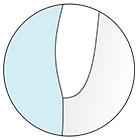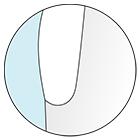Discover the dos and don'ts of tooth preparation to ensure precise preps regardless for crowns in lithium disilicate and zirconia.
Do’s
Respect the minimum material thickness and verify your reduction with e.g. a silicon key. Try to make an even reduction to achieve a constant, homogeneous thickness of your restoration. Create the type of margin that's clinically appropriate and that you are comfortable with.
Respect the homothety and ensure there is a single insertion axis. Follow the gingival scalloping during preparation.
Create the type of margin that's clinically appropriate and that you are comfortable with. While a round shoulder and deep chamfer are acceptable for all kinds of preparations, a feather edge such as in vertical preparation techniques is limited to restorations made of full-contour, 3Y-zirconia (e.g. Initial Zirconia Disk HT)

Round shoulder

Deep chamfer

Feather edge
Pay attention to leave a smoothly finished margin and to remove enamel beaks.
Don'ts
Avoid sharp internal angles and jump margins/enamel beaks. Fill undercuts with everX Flow. Avoid under-reduction and too parallel walls. These may result in an over-contoured restoration, chipping, cracking and internal stresses.

Jump margins

Undercut

Sharp angles
Don’t prepare a feather edge for lithium disilicate (e.g. Initial LiSi Block, Initial LiSi Press) or 5Y-zirconia (e.g. Initial Zirconia Disk UHT)
The occlusal surface shouldn’t be flat. An occlusal line ensures an even reduction of the occlusal surface and enhances the stabilisation of the restoration.
Do not leave the marginal crests but create sufficient space for the restoration instead.
- Łabno P, Drobnik K. Comparison of horizontal and vertical methods of tooth preparation for a prosthetic crown. J Pre Clin Clin Res. 2020;14(1):25-28.
- Goodacre CJ. Designing tooth preparations for optimal success. Dent Clin North Am. 2004;48(2):v, 359-85.

